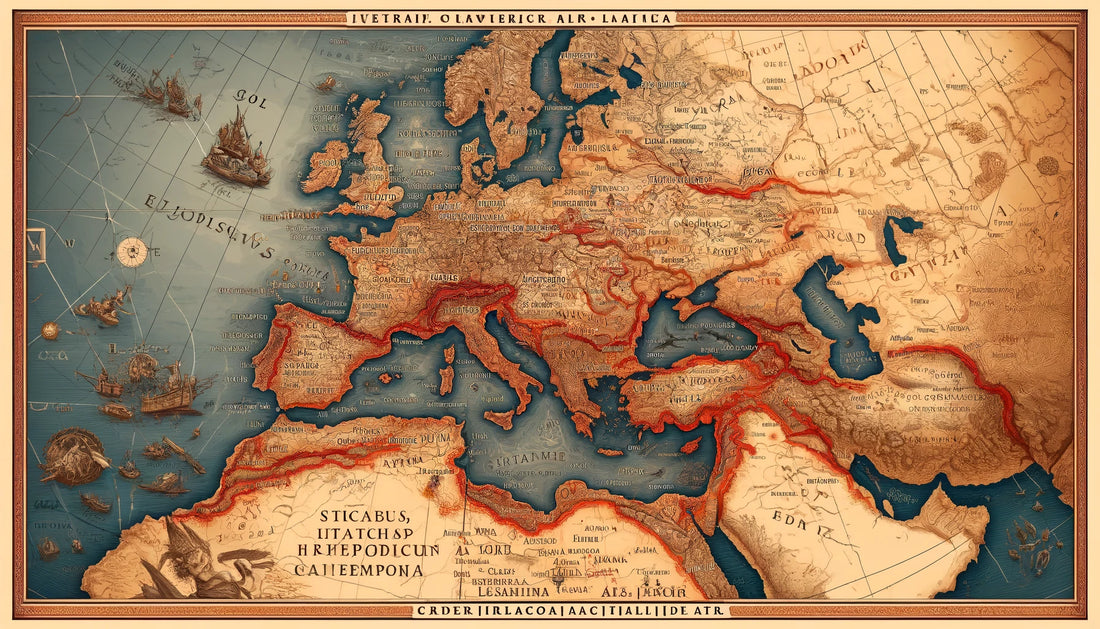
The Roman Empire at its greatest expansion
Alice PettirossoShare
The Roman Empire was one of the largest and most long-lasting empires in history, in the West its history began in 27 BC and ended in 476 AD, while in the East it lasted until 1453, known as the Byzantine Empire.
Founded by Augustus, the empire spanned three continents: Europe, Asia and Africa. It was characterized by a centralized political structure and a powerful army that ensured security and order in the provinces. Each province was governed by a representative of the emperor (such as a governor or procurator); the administrative division also included autonomous cities, colonies and municipalities.
With expansion, the need for more efficient management led to the creation of dioceses and prefectures under Emperor Diocletian in the 4th century AD. But the Roman Empire reached its greatest territorial extent in 117 AD under Emperor Trajan.
Expansion of the Empire
At the time, the Empire stretched on the horizontal axis from Britain in the west to Mesopotamia in the east, and on the vertical axis from North Africa in the south to the borders of Scotland in the north, covering approximately 5 million square kilometers. Trajan, emperor from 98 to 117 AD, was a skilled military commander and strategist, who carried out a series of campaigns of conquest that significantly expanded the borders of the Empire. Timeline of Trajan's expansion and highlights of his reign Conquest of Dacia (101-106 AD): One of Trajan's most important campaigns was against the Dacian kingdom, located in modern-day Romania.
The region was rich in mineral resources, particularly gold and silver, which contributed greatly to the Empire's finances. The victory over the Dacians is commemorated in the famous Trajan's Column, erected in Rome, which illustrates the phases of the war in detail. Campaigns in the East (113-117 AD): Trajan also conducted campaigns in the East, annexing Armenia, Assyria and parts of Mesopotamia, conquests that were strategically important for controlling the trade routes to the East and for consolidating Roman rule in the region.
The management of those territories, however, was complex and, upon Trajan's death, many were abandoned by his successor Hadrian. Construction companies: Trajan did not limit himself to military conquests but also undertook a vast program of works that transformed the face of Rome.
Among the most famous: Trajan's Forum and Trajan's Markets, which constituted a multifunctional complex for administrative, commercial and judicial activities. Trajan's Column is part of the complex. Social Policies and Reforms: Trajan also introduced important social reforms. One of the most significant was the Institutio Alimentaria, an assistance program that provided food to poor children in Italy, thus strengthening support for its administration and promoting social stability. Upon his death in 117 AD, Trajan left an empire at the height of its territorial splendor and with a thriving economy.
Maintaining those vast borders proved difficult, however, and his successor Hadrian decided to consolidate and defend the empire rather than expand it further. The expansion under Trajan not only increased the size of the Roman Empire but also brought new riches and greater cultural and political influence, traces of which are still visible in the monuments and works of art celebrating his reign.
The consequences of the Expansion
The expansion of the Roman Empire under Trajan had profound and lasting consequences on the Empire. He favored the spread of Roman culture, with Latin as the official language and Roman law as the common legal system. Romanization led to the spread of Roman habits, customs and architecture even in the most remote provinces. The new conquests, such as Dacia, rich in gold and silver mines, increased the financial resources of the Empire. The provinces enriched trade with local products, favoring a dense network of markets. The integration of new populations increased ethnic and cultural diversity, requiring careful political management to maintain unity.
Social policies such as the Institutio Alimentaria supported the weakest groups, guaranteeing social cohesion. The need to defend vast borders led to increased military spending and the construction of defensive infrastructure. The Empire had to manage the security of a large area, facing internal and external threats. The administration of a vast empire required a complex bureaucracy and reforms to improve the efficiency of the provincial government.
At the same time, the vastness of the empire also created challenges in internal communication and coordination. THE
Trajan's dream
During the campaign in Mesopotamia against the Parthians, Trajan reached the city of Ctesiphon, the capital of the Parthian kingdom. The conquest of this city was an ambitious and symbolic goal, since it represented the heart of Rome's historical enemy.
According to some sources, one night, while he was in Mesopotamia, Trajan had a premonitory dream. In this dream, the Parthian king appeared to him and gave him an arrow, a symbol of surrender and submission. This dream was interpreted as a divine sign of Rome's victorious destiny. Encouraged by the vision, Trajan determinedly continued his campaign, eventually managing to take Ctesiphon and establish Roman rule over the region. Despite the many military successes, the political and military reality proved to be very complex and, in fact, the dream remained a dream.
After Trajan's death in 117 AD, in fact, his successor Hadrian decided to abandon many of his eastern conquests, considering them unsustainable in the long term. The episode then highlights not only Trajan's ambition and determination, but also the practical difficulties of maintaining such a vast empire, because the extreme distances between Rome and the new eastern provinces made it complex to maintain efficient communications and direct control. and stable.
The infrastructure necessary to support the troops, guarantee supplies and administer the new lands required considerable resources, and the fascinating cultural differences, which made that remote legendary territory so coveted, became a source of misunderstandings and disagreements that were increasingly difficult to govern.

